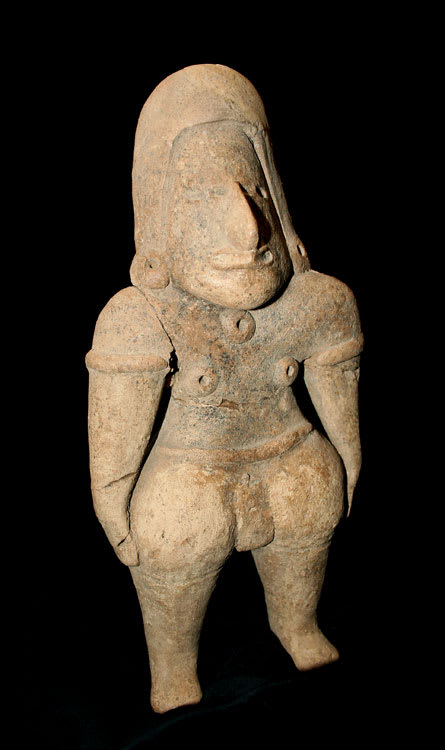Colima Terracotta Standing Figure, 300 BCE - 300 CE
Terracotta
11.25
GD.120
Further images
There are many distinct groups within the agglomeration referred to as the Western Mexico Shaft Tomb (WMST) tradition, foremost among them the Jalisco, Nayarit, and Colima. Their relationships are almost...
There are many distinct groups within the agglomeration referred to as the Western Mexico Shaft Tomb (WMST) tradition, foremost among them the Jalisco, Nayarit, and Colima. Their relationships are almost totally obscure due to the lack of contextual information. However, it is the artworks that are the most informative. All of the cultures encompassed under the WMST umbrella were in the habit of burying their dead in socially-stratified burial chambers at the base of deep shafts, which were in turn often topped by buildings. Originally believed to be influenced by the Tarascan people, who were contemporaries of the Aztecs, thermoluminescence has pushed back the dates of these groups over 1000 years.
Although the apogee of this tradition was reached in the last centuries of the 1st millennium BC, it has its origins over 1000 years earlier at sites such as Huitzilapa and Teuchitlan, in the Jalisco region. Little is known of the cultures themselves, although preliminary data seems to suggest that they were sedentary agriculturists with social systems not dissimilar to chiefdoms. These cultures are especially interesting to students of Mesoamerican history as they seem to have been to a large extent outside the ebb and flow of more aggressive cultures – such as the Toltecs, Olmecs and Maya – in the same vicinity. Thus insulated from the perils of urbanization, they developed very much in isolation, and it behooves us to learn what we can from what they have left behind.
The Colima are perhaps the most unusual stylistic subgroup of the West Mexican Tomb Shaft cultures. Characterized by a warm, red glaze, the figures are very measured and conservative, while at the same time displaying a great competence of line. Colima reclinatorios are a particularly remarkable achievement – curvilinear yet geometric assemblages of intersecting planes and enigmatic constructions in the semi-abstract. Hints of their social order can also be glimpsed in pieces depicting hunchbacks and other unusual characters. However, perhaps their most charming creations are the sculptures of obese dogs.
Although the apogee of this tradition was reached in the last centuries of the 1st millennium BC, it has its origins over 1000 years earlier at sites such as Huitzilapa and Teuchitlan, in the Jalisco region. Little is known of the cultures themselves, although preliminary data seems to suggest that they were sedentary agriculturists with social systems not dissimilar to chiefdoms. These cultures are especially interesting to students of Mesoamerican history as they seem to have been to a large extent outside the ebb and flow of more aggressive cultures – such as the Toltecs, Olmecs and Maya – in the same vicinity. Thus insulated from the perils of urbanization, they developed very much in isolation, and it behooves us to learn what we can from what they have left behind.
The Colima are perhaps the most unusual stylistic subgroup of the West Mexican Tomb Shaft cultures. Characterized by a warm, red glaze, the figures are very measured and conservative, while at the same time displaying a great competence of line. Colima reclinatorios are a particularly remarkable achievement – curvilinear yet geometric assemblages of intersecting planes and enigmatic constructions in the semi-abstract. Hints of their social order can also be glimpsed in pieces depicting hunchbacks and other unusual characters. However, perhaps their most charming creations are the sculptures of obese dogs.





